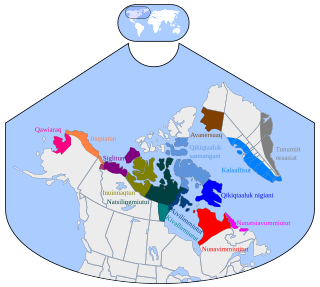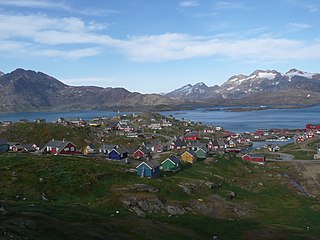
Greenland is an autonomous territory of the Kingdom of Denmark. It is the larger of two autonomous territories within the kingdom, the other being the Faroe Islands; the citizens of both territories are full citizens of Denmark. As Greenland is one of the Overseas Countries and Territories of the European Union, citizens of Greenland are European Union citizens. The capital and largest city of Greenland is Nuuk. Greenland lies between the Arctic and Atlantic oceans, east of the Canadian Arctic Archipelago. It is the world's largest island, and is the location of the northernmost point of land in the world—Kaffeklubben Island off the northern coast is the world's northernmost undisputed point of land; Cape Morris Jesup on the mainland was thought to be so until the 1960s. Economically, Greenland is heavily reliant on aid from Denmark, amounting to near half of the territory's total public revenue.

This is a demography of the population of Greenland including population density, ethnicity, economic status, religious affiliations and other aspects of the population.

The Inuit languages are a closely related group of indigenous American languages traditionally spoken across the North American Arctic and the adjacent subarctic regions as far south as Labrador. The Inuit languages are one of the two branches of the Eskimoan language family, the other being the Yupik languages, which are spoken in Alaska and the Russian Far East. Most Inuit people live in one of three countries: Greenland, a self-governing territory within the Kingdom of Denmark; Canada, specifically in Nunavut, the Inuvialuit Settlement Region of the Northwest Territories, the Nunavik region of Quebec, and the Nunatsiavut and NunatuKavut regions of Labrador; and the United States, specifically in northern and western Alaska.

The history of Greenland is a history of life under extreme Arctic conditions: currently, an ice sheet covers about eighty percent of the island, restricting human activity largely to the coasts. The first humans are thought to have arrived in Greenland around 2500 BCE. Their descendants apparently died out and were succeeded by several other groups migrating from continental North America. There has been no evidence discovered that Greenland was known to Norsemen until the ninth century CE, when Norse Icelandic explorers settled on its southwestern coast. The ancestors of the Greenlandic Inuit who live there today appear to have migrated there later, around the year 1200, from northwestern Greenland.

Nuuk is the capital of and most populous city in Greenland, an autonomous territory in the Kingdom of Denmark. Nuuk is the seat of government and the territory's largest cultural and economic center. Nuuk is also the seat of government for the Sermersooq municipality. In January 2024, it had a population of 19,872, – more than a third of the territory's population – making it one of the smallest capital cities in the world by population. Nuuk is considered a modernized city.

Ilulissat, formerly Jakobshavn or Jacobshaven, is the municipal seat and largest town of the Avannaata municipality in western Greenland, located approximately 350 km (220 mi) north of the Arctic Circle. With a population of 4,670 as of 2020, it is the third-largest city in Greenland, after Nuuk and Sisimiut. The city is home to almost as many sled-dogs as people.

The music of Greenland is a mixture of two primary strands, Inuit and Danish, mixed with influences from the United States and United Kingdom.

Greenlandic is an Eskimo–Aleut language with about 57,000 speakers, mostly Greenlandic Inuit in Greenland. It is closely related to the Inuit languages in Canada such as Inuktitut. It is the most widely spoken Eskimo–Aleut language. In June 2009, the government of Greenland, the Naalakkersuisut, made Greenlandic the sole official language of the autonomous territory, to strengthen it in the face of competition from the colonial language, Danish. The main variety is Kalaallisut, or West Greenlandic. The second variety is Tunumiit oraasiat, or East Greenlandic. The language of the Inughuit of Greenland, Inuktun or Polar Eskimo, is a recent arrival and a dialect of Inuktitut.

Kalaallisut, also known as West Greenlandic, is the primary language of Greenland and constitutes the Greenlandic language, spoken by the vast majority of the inhabitants of Greenland, as well as by thousands of Greenlandic Inuit in Denmark proper. It was historically spoken in the southwestern part of Greenland, i.e. the region around Nuuk.

Greenlanders, also called Greenlandics or Greenlandic people, are an Inuit ethnic group native to Greenland. As of 2024, Greenland's population stands at 55,840 and is in decline. Many Greenlanders are emigrating to other countries, particularly Denmark, where the population of native Greenlanders was around 18,563 as of 2018. Within Greenland, most residents live along the coastline, primarily in the central and southern regions, while the northern areas are less populated, as strongly influenced by climatic and geographical considerations.
Atuagagdliutit/Grønlandsposten, usually referred to as AG, is one of the two newspapers in Greenland distributed nationwide. The newspaper is published twice a week on Tuesdays and Thursdays.

The Kingdom of Denmark has only one official language, Danish, the national language of the Danish people, but there are several minority languages spoken, namely Faroese, German, and Greenlandic.

Inuktun is the language of approximately 1,000 indigenous Inughuit, inhabiting the world's northernmost settlements in Qaanaaq and the surrounding villages in northwestern Greenland.

The Inughuit, or the Smith Sound Inuit, historically Arctic Highlanders or Polar Eskimos, are an ethnic subgroup of the Greenlandic Inuit. They are the northernmost group of Inuit and the northernmost people in North America, living in Greenland. Inughuit make up about 1% of the population of Greenland.

The official language of Greenland is Greenlandic. The number of speakers of Greenlandic is estimated at 50,000, divided in three main dialects, Kalaallisut, Tunumiit and Inuktun. The remainder of the population mainly speaks Danish; Greenlandic Sign Language is the language of the deaf community.

The Greenlandic Inuit are the indigenous and most populous ethnic group in Greenland. Most speak Greenlandic and consider themselves ethnically Greenlandic. People of Greenland are both citizens of Denmark and citizens of the European Union.

Greenlandic independence is a political ambition of some political parties, advocacy groups, and individuals of Greenland, an autonomous territory within the Kingdom of Denmark, to become an independent sovereign state.

Greenlandic people in Denmark are residents of Denmark with Greenlandic or Greenlandic Inuit heritage. According to StatBank Greenland, as of 2020, there were 16,780 people born in Greenland living in Denmark, a figure representing almost one third of the population of Greenland. According to a 2007 Danish government report, there were 18,563 Greenlandic people living in Denmark. The exact number is difficult to calculate because of the lack of differentiation between Greenlandic and Danish heritage in Danish government records and also due to the fact that the way in which people identify themselves is not always a reflection of their birthplace. As of 2018, there were 2,507 Greenlanders enrolled in education in Denmark.

Iivit or Tunumiit are Indigenous Greenlandic Inuit from Iivi Nunaa, Tunu in the area of Kangikajik and Ammassalik, the eastern part of Inuit Nunaat. The Iivit live now mainly in Tasiilaq and Ittoqqortoormiit and are a part of the Arctic people known collectively as the Inuit. The singular for Iivit is Iik or for Tunumiit version it is Tunumiu.
The little Danes experiment, also known simply as the experiment, was a 1951 Danish operation where 22 Greenlandic Inuit children were sent to Danish foster families in an attempt to re-educate them as "little Danes". While the children were all supposed to be orphans, most were not. Six children were adopted while in Denmark, and sixteen returned to Greenland, only to be placed in Danish-speaking orphanages and never live with their families again. Half of the children experienced mental health disturbances, and half of them died in young adulthood. The government of Denmark officially apologised in 2020, after several years of demands from Greenlandic officials.


















